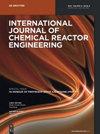作为固态超级电容器电极材料的甲基橙/还原氧化石墨烯复合材料
IF 1.6
4区 工程技术
Q3 Chemical Engineering
International Journal of Chemical Reactor Engineering
Pub Date : 2023-12-08
DOI:10.1515/ijcre-2023-0068
引用次数: 0
摘要
本文介绍了一种由电化学活性有机分子(即甲基橙(MO))和还原氧化石墨烯(rGO)复合材料组成的电极材料。由于有机分子的可持续性、氧化还原可逆性和氧化石墨烯的良好导电性,该复合材料被认为是一种潜在的超级电容器应用材料。为了制备对称型固态电池(MO/rGO//PVA/H2SO4//MO/rGO),将聚乙烯醇-硫酸(PVA/H2SO4)水凝胶聚合物电解质(GPE)夹在两个MO/rGO电极之间。研究发现,与PVA/H2SO4凝胶电解质界面的MO/rGO对称电池具有166.79 F g−1的比电容和11.58 Wh kg−1的能量密度,功率密度为6.25 kW kg−1。在这里,良好的比电容是双电层电容器(EDLC)和在制造电池中观察到的伪电容行为相结合的结果。经过2500次充放电循环后,比电容稳定,初始衰减为32% %。该合成材料和器件在超级电容器领域具有广阔的应用前景。本文章由计算机程序翻译,如有差异,请以英文原文为准。
Methyl-orange/reduced graphene oxide composite as the electrode material for the solid-state supercapacitor
Abstract Herein, we have introduced the electrode material made up of a composite of an electrochemical active organic molecule (i.e. methyl orange (MO)) and reduced graphene oxide (rGO) composite. This composite is found to be a potential material for supercapacitor application due to the sustainability, redox reversibility of organic molecules, and good conductivity of rGO. For fabricating symmetric solid-state cell (MO/rGO//PVA/H2SO4//MO/rGO), polyvinyl alcohol–sulphuric acid (PVA/H2SO4) aqueous gel polymer electrolyte (GPE) has been sandwiched between the two MO/rGO electrodes. It was found that a MO/rGO based symmetric cell interfaced with a PVA/H2SO4 gel electrolyte has a specific capacitance of 166.79 F g−1 and an energy density of 11.58 Wh kg−1 at a power density of 6.25 kW kg−1. Here, good specific capacitance is the result of a combination of both electric double-layer capacitor (EDLC) and pseudo-capacitive behaviour observed in a fabricated cell. The specific capacitance is stable after 2500 cycles of charge and discharge, with an initial fade of 32 %. This synthesized material and fabricated device found its potential to be used for the supercapacitor application.
求助全文
通过发布文献求助,成功后即可免费获取论文全文。
去求助
来源期刊
CiteScore
2.80
自引率
12.50%
发文量
107
审稿时长
3 months
期刊介绍:
The International Journal of Chemical Reactor Engineering covers the broad fields of theoretical and applied reactor engineering. The IJCRE covers topics drawn from the substantial areas of overlap between catalysis, reaction and reactor engineering. The journal is presently edited by Hugo de Lasa and Charles Xu, counting with an impressive list of Editorial Board leading specialists in chemical reactor engineering. Authors include notable international professors and R&D industry leaders.

 求助内容:
求助内容: 应助结果提醒方式:
应助结果提醒方式:


